

Develop - the JBoss Way. Introduction & Getting Started Get started developing The JBoss Way by following this inclusive tutorial.

The target audience for this tutorial are those individuals who do not yet have a great deal of experience with Eclipse + JBoss Tools (JBoss Developer Studio), JBoss Enterprise Application 6 or JBoss AS 7, Java EE 6 features like JAX-RS or HTML5 & jQuery for building an mobile web front-end. If you prefer to watch instead of read, a large portion of this content is also covered in video form at link. In this tutorial, we will touch on the following: - Working with JBoss Developer Studio (Eclipse + JBoss Tools) - Creating of a Java EE 6 project via a Maven archetype - Leveraging m2e and m2e-wtp - Using Forge to create a JPA entity - Using Hibernate Tools - Database Schema Generation - Deployment to a local JBoss Server - Adding a JAX-RS endpoint - Adding a jQuery Mobile client - Using the Mobile BrowserSim.
Java Thread Local – How to Use and Code Sample. We Recommend These Resources Thread Local is an interesting and useful concept, yet most of the Java developers are not aware of how to use that.

In this post, I’ll explain what is Thread Local and when to use it, with an example code. Since it’ll be little tough to understand this concept at first, I’ll keep the explanation as simple as possible (corollary: you shouldn’t use this code as it is in a production environment. Grasp the concept and improve upon it!)
Dependency Injection. Play Framework. Since 2007, we have been working on making Java web application development easier.
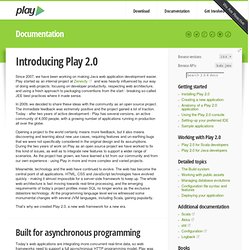
Play started as an internal project at Zenexity and was heavily influenced by our way of doing web projects: focusing on developer productivity, respecting web architecture, and using a fresh approach to packaging conventions from the start - breaking so-called JEE best practices where it made sense. In 2009, we decided to share these ideas with the community as an open source project. The immediate feedback was extremely positive and the project gained a lot of traction.
Let it Crash: Paradigma für fehlertolerante, massiv-parallele Software. Ständig wird propagiert, dass Entwickler Fehler und Ausnahmen im Programm tunlichst vermeiden oder zur Not abfangen und sinnvoll behandeln sollen.
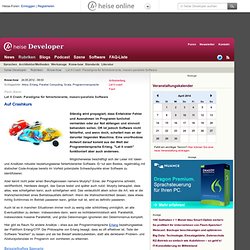
Oft ist jedoch Software nicht fehlerfrei, und wenn doch, scheitert man an der darunter liegenden Maschine. Eine unorthodoxe Antwort darauf kommt aus der Welt der Programmiersprache Erlang. "Let it crash" funktioniert aber auch anderswo. Sbt — sbt Documentation. Programming Rules. Programming Rules and Conventions Table of Contents Author: EPK/NP Klas Eriksson, EUA/SU M Williams, J Armstrong Document: EPK/NP 95:035 Program Development Using Erlang - Programming Rules and Conventions.
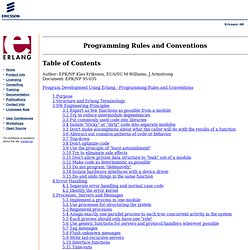
Actor Systems. Actors are objects which encapsulate state and behavior, they communicate exclusively by exchanging messages which are placed into the recipient’s mailbox.
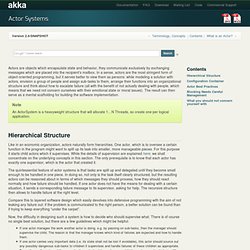
In a sense, actors are the most stringent form of object-oriented programming, but it serves better to view them as persons: while modeling a solution with actors, envision a group of people and assign sub-tasks to them, arrange their functions into an organizational structure and think about how to escalate failure (all with the benefit of not actually dealing with people, which means that we need not concern ourselves with their emotional state or moral issues). The result can then serve as a mental scaffolding for building the software implementation. Note. Node.js. Architektur[Bearbeiten] JavaScript gibt eine ereignisgesteuerte Architektur vor, die im Serverbetrieb den Vorteil hat, pro bestehender Verbindung weniger Arbeitsspeicher zu verbrauchen als bei vergleichbaren Anwendungen, die für jede geöffnete Verbindung einen eigenen Thread starten.

Module[Bearbeiten] GRASP. Sie beschreiben also allgemein welche Klassen und Objekte wofür zuständig sein sollten.
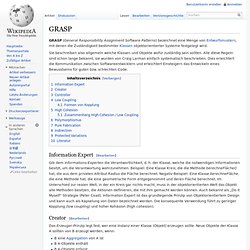
Alle diese Regeln sind schon lange bekannt, sie wurden von Craig Larman einfach systematisch beschrieben. Dies erleichtert die Kommunikation zwischen Softwareentwicklern und erleichtert Einsteigern das Entwickeln eines Bewusstseins für guten bzw. schlechten Code. Information Expert[Bearbeiten]
CodeKata. Kommando (Entwurfsmuster) Wenn z.
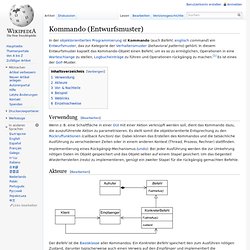
B. eine Schaltfläche in einer GUI mit einer Aktion verknüpft werden soll, dient das Kommando dazu, die auszuführende Aktion zu parametrisieren. Es stellt somit die objektorientierte Entsprechung zu den Rückruffunktionen (callback function) dar. Dabei können das Erstellen des Kommandos und die tatsächliche Ausführung zu verschiedenen Zeiten oder in einem anderen Kontext (Thread, Prozess, Rechner) stattfinden. Implementierung eines Rückgängig-Mechanismus (undo): Bei jeder Ausführung werden die zur Umkehrung nötigen Daten im Objekt gespeichert und das Objekt selber auf einem Stapel gesichert.
Um das Gegenteil Wiederherstellen (redo) zu implementieren, genügt ein zweiter Stapel für die rückgängig gemachten Befehle. Fassade (Entwurfsmuster) Die Fassade fördert die lose Kopplung, weil mehrere Schnittstellen zu einer zusammengefasst werden, und senkt die Komplexität, da sie das zugrunde liegende Subsystem versteckt.

Außerdem kann das Subsystem durch die lose Kopplung leichter erweitert werden. Der Nachteil besteht darin, dass eine zusätzliche Indirektionsstufe eingeführt wird. Facade Die Fassade. Sie verweist auf die Klassen Class1, Class2 und Class3.